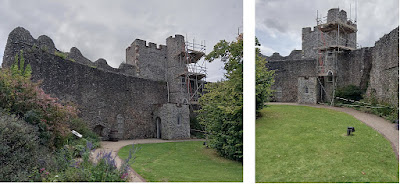A Visit to Lewes.
A few weeks ago, I visited the market town of Lewes in Sussex, best known to me as the site of the crucial defeat of King Henry III and his son, the Lord Edward, in May 1264.
My only other visit to the town was back in the late 1990s, when I was the "Medieval Weapons Expert" in a TV episode about a skull (see below) that had been found at the medieval hospital site in Lewes and was thought to be a casualty of the battle.
In fact, when carbon dated some years later, the skull was found to be from 200 years before the Battle of Lewes and contemporary with the Battle of Hastings. For more on this take a look at this article.
Anyway back to my recent visit, the first place I went to was Lewes Castle, a rarity amongst English castles as it was built with two mottes and the bailey between them. It was first built by William de Warenne in 1068, early in the Norman Conquest. At first, it was constructed of timber and had a single motte. By 1100, the timber palisade had been replaced by stone and the shell keep that still survives had been built.
This picture looks north from the remaining shell keep towards the site of the battle in 1264.
Sadly, I didn't have time to get up to the battlefield site but hopefully I will be back in this area again next year and I'll try to fit it in.
This model gives an idea of how the castle site looked around the time of the battle.
Opposite the castle is the Barbican House Museum which houses the town's archaeology and local history exhibitions.
Some 13th century floor tiles on display in the museum. I particularly like the knight on the left and the king on the right who may be Edward I. Apologies for the reflections; it was a very sunny day.
I also had a quick look at Lewes Priory as most of its remains are in a public park.
Lewes Priory was founded by William de Warenne and his wife Gundrada around 1081 on the site of an earlier Saxon timber church. It was a community of Cluniac monks, the first in Britain. The priory was dedicated to St. Pancreas. The Priory's church was huge, bigger than some cathedrals, echoing the church at the order's founding house of "Reformed Benedictines" at Cluny in France. For more information about the Priory, take a look at the website of the Lewes Priory Trust.
Part of the monks' dormitory.
In 1264, before riding out to the Battle of Lewes on the 14th May, King Henry III stayed in the priory. After losing the battle, Henry retreated, with many of his remaining troops, back into the Priory precinct. Simon de Montfort attacked the priory and forced over Henry to surrender.
It was in the priory, shortly after the battle, that Henry signed the “Mise
of Lewes” stating that he would accept the rulings of the Barons effectively making Simon de Monfort the "de facto" ruler of the kingdom.
Also in the park, there is a memorial to those who fought and died in the Battle of Lewes in 1264 that was unveiled on the 700th anniversary. Sir Tufton Beamish MP wrote "Battle Royale", one of the better books (although now slightly outdated) on Simon de Montfort's rebellion.













No comments:
Post a Comment